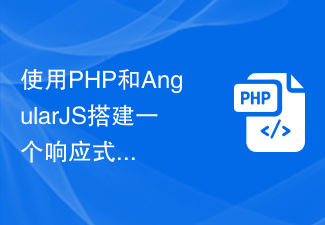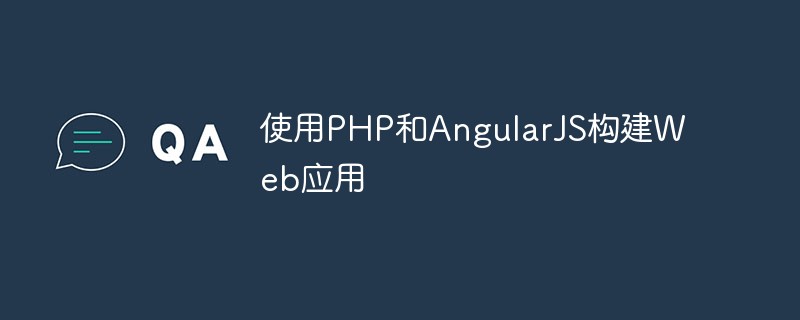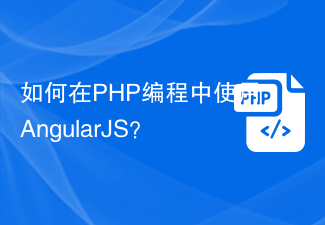For me, a complete novice in the front-end, I still know little about Javascript. If I want to get started with angular JS directly, I encounter a lot of resistance. However, I believe that as long as we work hard, even anti-human designs will not be a big problem.
Okay, no more nonsense. In order to understand what angular JS is, I started with Scope. So what is Scope? Borrowing a passage from the official document:
"scope is an object that refers to the application model. It is an execution context for expressions. Scopes are arranged in hierarchical structure which mimic the DOM structure of the application. Scopes can watch expressions and propagate events."
After reading this, by analogy to other programming languages, I feel that Scope is like the scope of the Data Model, providing context for the execution of Expressions. Let’s understand it this way for now.
Features of Scope
Next, let’s see what features Scope has?
Scope provides the $watch method to monitor Model changes.
Scope provides the $apply method to propagate Model changes.
Scope can be inherited to isolate different application components and property access permissions.
Scope provides context for the evaluation of Expressions.
Regarding these four features, because I have studied ActionScript, C, and Java before, the first, third, and fourth points are not difficult to understand, but the second point feels a bit unclear. In line with the principle of asking for answers, I still found some things through Google. For experienced veterans, please tap on the bricks!
Origin Javascript
First of all, at first glance, scope.apply() seems to be an ordinary method for updating bindings. But think a little more, why do we need it? When is it usually used? To understand these two issues, we have to start with Javascript. In Javascript code, it is executed in a certain order. When it is the turn of a code fragment to be executed, the browser will only execute the current fragment and will not do anything else. So sometimes some web pages that are not very well made will get stuck after clicking on something. The way Javascript works is one of the reasons for this phenomenon! Below we have a piece of code to feel it:
var button = document.getElementById('clickMe');
function buttonClicked () {
alert('the button was clicked');
}
button.addEventListener('click', buttonClicked);
function timerComplete () {
alert('timer complete');
}
setTimeout(timerComplete, 5000);
When loading Javascript code, first find a button with an id called "clickMe", then add a listener, and then set a timeout. Wait 5 seconds and a dialog box will pop up. If you refresh the page and click the clickMe button immediately, a dialog box will pop up. If you don't click OK, the timerComplete function will never have a chance to execute.
How to update bindings
Okay, after talking about some seemingly irrelevant things, let’s get back to the topic. How does angular JS know when data changes and the page needs to be updated? The code needs to know when the data has been modified, but there is currently no way to directly notify that the data on an object has changed (although ECMAScript 5 is trying to solve this problem, it is still in the experimental stage). The currently more mainstream strategies include the following two solutions. One is to use a special object so that all data can only be set by calling the object's method instead of directly specifying it through the property. In this way, all modifications can be recorded, and you will know when the page needs to be updated. The disadvantage of this is that we must inherit a special object. Assignment can only be done through object.set('key', 'value') instead of object.key=value. In frameworks, like EmberJS and KnockoutJS do this (although I have never been exposed to it - embarrassing). The other is the method adopted by angular JS, which checks whether there are any data changes after each Javascript code execution sequence is executed. This seems inefficient and may even seriously impact performance. However, angular JS uses some clever methods to solve this problem (it has not been studied yet, and it is not clear yet). The advantage of this is that we can use any object at will, there are no restrictions on the assignment method, and we can also detect changes in the data.
For this solution adopted by angular JS, what we care about is when the data changes, and this is where scope.apply() comes in handy. Checking whether the bound data has changed is actually done by scope.digest(), but we almost never call this method directly, but call the scope.apply() method because in scope In the .apply() method, it will call the scope.digest() method. The scope.apply() method takes a function or expression, executes it, and finally calls the scope.digest() method to update bindings or watchers.
When to use $apply()
It’s still the same question, when do we need to call the apply() method? The situation is very rare. In fact, almost all our code is wrapped in scope.apply(), such as ng-click, controller initialization, http callback function, etc. In these cases, we don't need to call it ourselves. In fact, we can't call it ourselves, otherwise calling the apply() method inside the apply() method will throw an error. We really need to use it if we need to run the code in a new execution sequence, and if and only if this new execution sequence is not created by the angular JS library method, at this time we need to use scope for the code. apply() wrapped. Let’s use an example to explain:
functionCtrl($scope) {
$scope.message ="Waiting 2000ms for update";
setTimeout(function () {
$scope.message="Timeout called!";
// AngularJS unaware of update to $scope
}, 2000);
}
After the above code is executed, the page will display: Waiting 2000ms for update. Apparently the data update is not noticed by angular JS.
Next, we slightly modify the Javascript code and wrap it with scope.apply().
functionCtrl($scope) {
$scope.message ="Waiting 2000ms for update";
setTimeout(function () {
$scope.$apply(function () {
$scope.message="Timeout called!";
});
}, 2000);
}
The difference this time is that the page will first display: Waiting 2000ms for update. After waiting for 2 seconds, the content will be changed to: Timeout called!. Obviously the data update is noticed by angular JS.
NOTE: We should not do this, but use the timeout method provided by angular JS, so that it will be automatically wrapped with the apply method.
Science is a double-edged sword
Finally, let’s take another look at the scope.apply() and scope.apply(function) methods! Although angular JS has done a lot for us, we have also lost some opportunities. You can tell at a glance from the pseudocode below:
function$apply(expr) {
try {
return$eval(expr);
} catch(e) {
$exceptionHandler(e);
} finally {
$root.$digest();
}
}
It will catch all exceptions and will not throw them again. Finally, the $digest() method will be called.
To summarize
The $apply() method can execute angular JS expressions outside the angular framework, such as DOM events, setTimeout, XHR or other third-party libraries. This is just the beginning, the water is still very deep, everyone is welcome to take a deep dive together!
 2022年最新5款的angularjs教程从入门到精通Jun 15, 2017 pm 05:50 PM
2022年最新5款的angularjs教程从入门到精通Jun 15, 2017 pm 05:50 PMJavascript 是一个非常有个性的语言. 无论是从代码的组织, 还是代码的编程范式, 还是面向对象理论都独具一格. 而很早就在争论的Javascript 是不是面向对象语言这个问题, 显然已有答案. 但是, 即使 Javascript 叱咤风云二十年, 如果想要看懂 jQuery, Angularjs, 甚至是 React 等流行框架, 观看《黑马云课堂JavaScript 高级框架设计视频教程》就对了。
 使用PHP和AngularJS搭建一个响应式网站,提供优质的用户体验Jun 27, 2023 pm 07:37 PM
使用PHP和AngularJS搭建一个响应式网站,提供优质的用户体验Jun 27, 2023 pm 07:37 PM在如今信息时代,网站已经成为人们获取信息和交流的重要工具。一个响应式的网站能够适应各种设备,为用户提供优质的体验,成为了现代网站开发的热点。本篇文章将介绍如何使用PHP和AngularJS搭建一个响应式网站,从而提供优质的用户体验。PHP介绍PHP是一种开源的服务器端编程语言,非常适用于Web开发。PHP具有很多优点,如易于学习、跨平台、丰富的工具库、开发效
 使用PHP和AngularJS构建Web应用May 27, 2023 pm 08:10 PM
使用PHP和AngularJS构建Web应用May 27, 2023 pm 08:10 PM随着互联网的不断发展,Web应用已成为企业信息化建设的重要组成部分,也是现代化工作的必要手段。为了使Web应用能够便于开发、维护和扩展,开发人员需要选择适合自己开发需求的技术框架和编程语言。PHP和AngularJS是两种非常流行的Web开发技术,它们分别是服务器端和客户端的解决方案,通过结合使用可以大大提高Web应用的开发效率和使用体验。PHP的优势PHP
 使用PHP和AngularJS开发一个在线文件管理平台,方便文件管理Jun 27, 2023 pm 01:34 PM
使用PHP和AngularJS开发一个在线文件管理平台,方便文件管理Jun 27, 2023 pm 01:34 PM随着互联网的普及,越来越多的人在使用网络进行文件传输和共享。然而,由于各种原因,使用传统的FTP等方式进行文件管理无法满足现代用户的需求。因此,建立一个易用、高效、安全的在线文件管理平台已成为了一种趋势。本文介绍的在线文件管理平台,基于PHP和AngularJS,能够方便地进行文件上传、下载、编辑、删除等操作,并且提供了一系列强大的功能,例如文件共享、搜索、
 如何使用PHP和AngularJS进行前端开发May 11, 2023 pm 05:18 PM
如何使用PHP和AngularJS进行前端开发May 11, 2023 pm 05:18 PM随着互联网的普及和发展,前端开发已变得越来越重要。作为前端开发人员,我们需要了解并掌握各种开发工具和技术。其中,PHP和AngularJS是两种非常有用和流行的工具。在本文中,我们将介绍如何使用这两种工具进行前端开发。一、PHP介绍PHP是一种流行的开源服务器端脚本语言,它适用于Web开发,可以在Web服务器和各种操作系统上运行。PHP的优点是简单、快速、便
 如何在PHP编程中使用AngularJS?Jun 12, 2023 am 09:40 AM
如何在PHP编程中使用AngularJS?Jun 12, 2023 am 09:40 AM随着Web应用程序的普及,前端框架AngularJS变得越来越受欢迎。AngularJS是一个由Google开发的JavaScript框架,它可以帮助你构建具有动态Web应用程序功能的Web应用程序。另一方面,对于后端编程,PHP是非常受欢迎的编程语言。如果您正在使用PHP进行服务器端编程,那么结合AngularJS使用PHP将可以为您的网站带来更多的动态效
 使用Flask和AngularJS构建单页Web应用程序Jun 17, 2023 am 08:49 AM
使用Flask和AngularJS构建单页Web应用程序Jun 17, 2023 am 08:49 AM随着Web技术的飞速发展,单页Web应用程序(SinglePageApplication,SPA)已经成为一种越来越流行的Web应用程序模型。相比于传统的多页Web应用程序,SPA的最大优势在于用户感受更加流畅,同时服务器端的计算压力也大幅减少。在本文中,我们将介绍如何使用Flask和AngularJS构建一个简单的SPA。Flask是一款轻量级的Py


Hot AI Tools

Undresser.AI Undress
AI-powered app for creating realistic nude photos

AI Clothes Remover
Online AI tool for removing clothes from photos.

Undress AI Tool
Undress images for free

Clothoff.io
AI clothes remover

AI Hentai Generator
Generate AI Hentai for free.

Hot Article

Hot Tools

SAP NetWeaver Server Adapter for Eclipse
Integrate Eclipse with SAP NetWeaver application server.

Dreamweaver Mac version
Visual web development tools

ZendStudio 13.5.1 Mac
Powerful PHP integrated development environment

Atom editor mac version download
The most popular open source editor

SublimeText3 Linux new version
SublimeText3 Linux latest version







